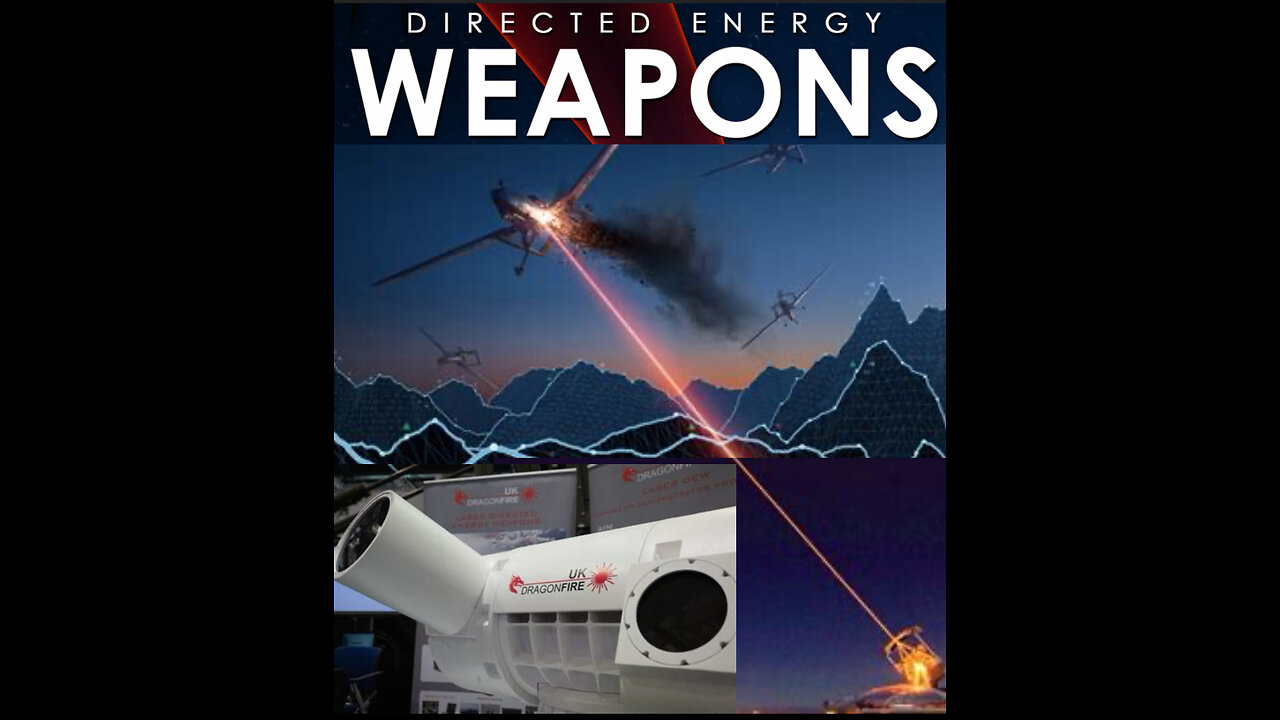Premium Only Content

Dragonfire and the Future of Laser Weaponry: A New Era in Defense Technology
The unveiling of the Dragonfire laser directed energy weapon system marks a significant leap forward in military technology. With its unprecedented precision and cost-effectiveness, Dragonfire is poised to revolutionize the landscape of modern warfare. As militaries across the globe race to develop similar systems, this innovation raises questions about the future of defense strategies, international arms races, and the ethical implications of such advancements.
Dragonfire: The Cutting-Edge Laser Weapon
The Dragonfire system, developed in the United Kingdom, represents a pinnacle of directed energy weapon (DEW) technology. This state-of-the-art system utilizes a high-energy laser beam capable of destroying targets with pinpoint accuracy.
Key Features:
• Precision: Dragonfire can hit a target the size of a £1 coin from a distance of one kilometer, ensuring minimal collateral damage.
• Cost-Effectiveness: Each shot costs an estimated £10, covering only the energy required, compared to thousands of pounds per missile. This stark cost disparity positions Dragonfire as a game-changing technology, especially in prolonged engagements.
• Versatility: Designed for deployment on both land and sea platforms, Dragonfire can counter a wide array of threats, from drones to missiles and potentially even incoming artillery shells.
Laser Weapons in Action: Advantages and Applications
Laser-directed energy weapons like Dragonfire offer several advantages over traditional kinetic weapons:
1. Infinite Ammunition: As long as there is a power source, the weapon can fire indefinitely, bypassing supply chain issues inherent with conventional munitions.
2. Pinpoint Accuracy: The ability to destroy targets with surgical precision minimizes unintended damage, making it ideal for urban or sensitive environments.
3. Speed of Light Engagement: Unlike missiles or projectiles, lasers travel at the speed of light, making them highly effective against fast-moving or evasive targets.
4. Cost Efficiency: The operational cost of £10 per shot is a fraction of the expense associated with traditional munitions, reducing the financial burden of sustained operations.
Global Race for Directed Energy Weapons
The Dragonfire system places the UK in a competitive position within the global arms race for DEWs. Other nations are rapidly developing similar technologies, each with unique capabilities tailored to their defense strategies.
• Israel’s Iron Beam: Complementing its Iron Dome system, the Iron Beam is designed to neutralize short-range threats, including drones and rockets, at a fraction of the cost of interceptor missiles.
• United States’ Laser Weapons: The U.S. military has been testing systems like the Navy’s Laser Weapon System (LaWS) and the Army’s Directed Energy Maneuver-Short Range Air Defense (DE M-SHORAD), focusing on drone defense and countering rocket, artillery, and mortar fire.
• China’s Advances: With substantial investments in laser technology, China is reportedly developing systems aimed at neutralizing satellites, drones, and hypersonic missiles.
Strategic Implications
Dragonfire and similar systems could reshape military strategies and defense doctrines worldwide. Here are some of the potential implications:
1. Neutralizing the Drone Threat
Drones have become a major component of modern warfare, used for reconnaissance, logistics, and combat. Dragonfire’s effectiveness against drones provides a critical countermeasure, particularly against swarms of low-cost, high-impact UAVs.
2. Reducing Reliance on Traditional Ammunition
Laser weapons eliminate the need for expensive and resource-intensive supply chains for ammunition. This could lead to a shift in defense budgets and logistics, freeing resources for other areas of military development.
3. Changing Naval Warfare
In maritime scenarios, laser weapons like Dragonfire offer a cost-effective solution for protecting ships against missiles and drones. Their versatility and low cost make them ideal for prolonged naval operations.
Challenges and Ethical Considerations
Despite their advantages, directed energy weapons face several challenges and raise important ethical questions.
Technical Challenges
• Power Supply: High-energy lasers require substantial power sources, which may limit their deployment in certain scenarios.
• Atmospheric Interference: Weather conditions like rain, fog, and dust can disrupt laser beams, reducing their effectiveness.
• Cooling Systems: Preventing overheating during sustained use is a critical engineering challenge.
Ethical Concerns
• Proliferation Risks: As DEWs become more accessible, there is a risk of these systems falling into the hands of non-state actors or rogue regimes.
• Escalation of Conflict: The lower cost of laser weapon engagement might encourage more frequent use, potentially escalating conflicts.
• Civilian Infrastructure: The potential misuse of DEWs against civilian targets or critical infrastructure raises significant concerns about compliance with international law.
Looking Ahead: The Next Frontier in Defense
The Dragonfire laser system underscores the transformative potential of directed energy weapons in reshaping modern warfare. As the technology matures, its integration into defense strategies will likely expand, influencing everything from national security to global power dynamics.
Key Questions for the Future:
• Will laser weapons make traditional munitions obsolete in certain theaters of war?
• How will nations regulate and control the proliferation of such technologies?
• Could DEWs be used in non-lethal roles, such as crowd control or infrastructure defense?
Dragonfire represents just the beginning of a new era in defense technology. As militaries around the world refine their laser systems, the race for supremacy in directed energy weapons will undoubtedly shape the future of global security.
-
 3:06
3:06
FragmentsOfTruth
1 day agoJonathan Pryce and the Pope: Are We Watching a Scripted Role on the World Stage?
175 -
 12:26
12:26
EvenOut
12 hours ago $10.38 earnedWe Got Cosmestic Surgery That Went Wrong! Twin Switch-Up!
44.6K6 -
 1:15:07
1:15:07
Ami's House
18 hours ago $8.42 earnedWhat an ACTUAL Military Expert Thinks of the War in Gaza – Nick Freitas | FULL EP
26.8K14 -
 2:54:02
2:54:02
TimcastIRL
10 hours agoLiberal Media CAUGHT In BOGUS LEAK, Trump DID NOT Fire Mike Waltz, HE PROMOTED HIM | Timcast IRL
225K129 -
 9:05:24
9:05:24
MyronGainesX
17 hours ago $26.66 earnedSam Seder Embarrasses Ethan Klein, The Truth On MLK's Murder, Panel Debate w/ Anton Daniels
81.9K21 -
 1:09:38
1:09:38
Man in America
13 hours agoEXPOSED: How Militaries Worldwide Are Engineering DEPOPULATION w/ Todd Callender
74K49 -
 8:00:02
8:00:02
SpartakusLIVE
11 hours agoNEW Update, NEW Weapons, NEW META?!? || Quads in VERDANSK
34.3K -
 5:14:28
5:14:28
Jokeuhl Gaming and Chat
9 hours agoEmpyrion - Galactic Survival Long Range Jump Aquired
43.8K1 -
 4:42:30
4:42:30
Right Side Broadcasting Network
1 day agoLIVE REPLAY: President Trump Gives Commencement Address at University of Alabama - 5/1/25
170K22 -
 16:58
16:58
T-SPLY
15 hours agoDems’ Bad News: El Salvador Rejects Abrego, Democrats Fume!
109K67